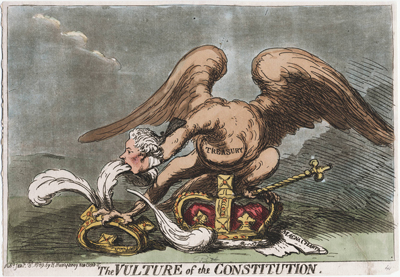The Vulture of the Constitution
Two events dominated the news in the latter half of 1788, and both play a role in this print. One was the trial of Warren Hastings. The other was the growing concern with King George's health and sanity.
The Warren Hastings trial was a media circus which attracted widespread attention and for which admission to the audience gallery was as difficult to obtain as tickets to the World Cup. In the course of the trial, speeches of which were reported in detail, Hastings governorship and by extension British rule in India was often characterized using the analogy of a vulture. In the London Templar, for August 1st, 1788 p. 15, for instance, Gillray might have seen this:
Such was the manner in which the English, under the auspices of Mr. Hastings protected their allies in India. . . It was the protection of the vulture to the lamb, which covers while it devours its prey—which stretching its baleful pinions, and hovering in mid air, disperses the hawks and kites, and saves the innocent and helpless victim from all talons but its own.

© Lewis Walpole Library, Yale University
By November of 1788, it was impossible to deny that the King was seriously ill and something had to be done. Abandoning his longstanding defense of parliamentary powers, Fox argued that the Prince of Wales had "as clear, as express a right to assume the reins of government, and exercise the power of sovereignty" during the King's illness as he would have if the King had died. Parliament had no role but to approve. Pitt and the Tories strenously and, as it turned out, successfully objected. Knowing that a Regency would mean a complete change of ministry, Pitt and the Tories argued the need for Parliament to examine historical precedents to protect the still reigning (though incapacitated) monarch and even more their Parliamentary prerogative to choose the Regent and determine what powers the Regent would have.
In a somewhat awkward return to almost emblematic techniques of early caricature, Gillray portrays Pitt in his role as Prime Minister and Lord of the Treasury as a vulture, the Whigs and the Prince by the three-plumed coronet of the Prince of Wales, and King George by the Royal Crown. Like the vulture in my earlier quotation from the Hastings trial, Pitt hovers over the Crown with wings extended, pushing away the Prince and plucking his feathers as if the Prince were an attacking hawk. But like the vulture in the quotation, the defense of the Crown is completely self-serving. Pitt's other talon is firmly grasping the Royal Scepter, and the foundational document of the British constitution, the Magna Carta, is in tatters.
The print, published in January 1789, is crude in comparison with other Gillray prints of the period and follows at least two other prints which were unusally critical of Pitt (Election Troops Bringing in their Accounts to the Pay Table and King Pitt. It precedes a "serious" portrait of Pitt which, though not a caricature, contains enough ambiguity in its presentation to suggest a definite "falling out" between Gillray and the Tories. But if Gillray was less than pleased with Pitt, it was hardly sufficient to push him towards Fox and the Whigs, whom he consistently and deeply distrusted.
Sources and Reading
- Commentary from the British Museum on The Vulture of the Constitution
- Draper Hill, Mr. Gillray The Caricaturist, 1965 p. 32n
- "William Pitt the Younger," Wikipedia
- "George IV of the United Kingdom and the Regency Crisis" Wikipedia
- Thomas Wright and R.H. Evans, Historical and Descriptive Account of the Caricatures of James Gillray #41
Comments & Corrections
NOTE: Comments and/or corrections are always appreciated. To make that easier, I have included a form below that you can use. I promise never to share any of the info provided without your express permission.